Design and Implementation of a Crowdsensing-Based Air Quality Monitoring Open and FAIR Data Infrastructure
Abstract
1. Introduction
2. Materials and Methods
2.1. PM Sensors
2.1.1. LCS Performances
2.1.2. Statistical Analysis
LCS Precision
LCS Accuracy
2.1.3. LCS Performances Improvement
2.2. Deployment on Mobile Platforms
Limitations of Mobile Platforms
2.3. Data Acquisition and Transmission
2.4. Data Management
2.5. Data Processing
2.5.1. Window Averaging
2.5.2. Correction of LCS Data
2.5.3. Interpolation and Contouring
- (i)
- The accuracy of the method and how far the interpolated values from the samples are still meaningful, i.e., a consideration on “extrapolation”. This issue can be partially solved by the definition of an area of interpolation, such as the bounding box or (better) the convex hull of the samples as the first approximation.
- (ii)
- The computational complexity and the relative speed of the interpolation method, which must comply with the near real-time requirement. In our implementation, we chose a very quick and sufficiently accurate method, inverse distance weighting (IDW). IDW interpolation is defined as follows. Assuming that {x1 …xN} are the interpolating points (samples) and x a generic point, the interpolant is:
- (iii)
- In addition, there is an epistemological aspect to be further considered: all processing is automatic and cannot be assisted by human intervention. This fact excludes algorithms such as Kriging, which involve many discretional models and parameters. An excellent alternative solution is natural neighbor interpolation (Sibson’s method), which is based only on the geometrical properties of the dataset and is approximately ten times slower than IDW [50]. Lastly, it is necessary to define the levels for the contouring in some adaptive way to improve the readability and also the color map for the interpolation, which must be coherent with all other data visualizations. The interpolation/contouring is implemented on the SPS with a Python script that reads the averaged values, applies the IDW method (with exponent p = 3), generates the contour and produces a transparent PNG image with a small text file for the georeferentiation. The image is clipped around the convex hull of the dataset, excluding the external area.
2.5.4. Near-Real-Time Web-Based Visualization
2.5.5. Advanced Analysis
2.5.6. Open and FAIR Data Access
3. Results
4. Conclusions and Future Work
Author Contributions
Funding
Institutional Review Board Statement
Informed Consent Statement
Data Availability Statement
Acknowledgments
Conflicts of Interest
References
- Air Pollution. Available online: https://www.who.int/health-topics/air-pollution (accessed on 20 February 2023).
- Almetwally, A.A.; Bin-Jumah, M.; Allam, A.A. Ambient air pollution and its influence on human health and welfare: An overview. Environ. Sci. Pollut. Res. 2020, 27, 24815–24830. [Google Scholar] [CrossRef]
- Di Turo, F.; Proietti, C.; Screpanti, A.; Fornasier, M.F.; Cionni, I.; Favero, G.; De Marco, A. Impacts of air pollution on cultural heritage corrosion at European level: What has been achieved and what are the future scenarios. Environ. Pollut. 2016, 218, 586–594. [Google Scholar] [CrossRef]
- Cachier, H.; Sarda-Estève, R.; Oikonomou, K.; Sciare, J.; Bonazza, A.; Sabbioni, C.; Greco, M.; Saiz-Jimenez, C.; Hermosin, A.; Reyes, J. Aerosol Characterization and Sources in Different European Urban Atmospheres: Paris, Seville, Florence and Milan. In Air Pollution and Cultural Heritage; Taylor and Francis Group: Abingdon, UK, 2004; Available online: https://scholar.google.com/scholar_lookup?title=Aerosol%20characterization%20and%20sources%20in%20different%20European%20urban%20atmospheres%3A%20Paris%2C%20Seville%2C%20Florence%20and%20Milan&publication_year=2004&author=H.%20Cachier&author=R.%20Sarda-Est%C3%A8ve&author=K.%20Oikonomou&author=J.%20Sciare&author=A.%20Bonazza&author=C.%20Sabbioni&author=M.%20Greco&author=J.%20Reyes&author=B.%20Hermosin&author=C.%20Saiz-Jimenez (accessed on 20 February 2023).
- United States Environmental Protection Agency. Clean Air Act Text. Available online: https://www.epa.gov/clean-air-act-overview/clean-air-act-text (accessed on 21 February 2023).
- Directive 2008/50/EC of the European Parliament and of the Council of 21 May 2008 on Ambient Air Quality and Cleaner Air for Europe. Off. J. Eur. Union 2008, 152, 169–212. Available online: http://data.europa.eu/eli/dir/2008/50/oj/eng (accessed on 21 February 2023).
- European Environment Agency. European City Air Quality Viewer. Available online: https://www.eea.europa.eu/themes/air/urban-air-quality/european-city-air-quality-viewer (accessed on 22 February 2023).
- United States Environmental Protection Agency. Interactive Map of Air Quality Monitors. Available online: https://www.epa.gov/outdoor-air-quality-data/interactive-map-air-quality-monitors (accessed on 22 February 2023).
- Strzelecki, M.; Stezycki, K. “Burn Everything”: Poland Chokes on the Smog of War. Reuters, 8 December 2022. Available online: https://www.reuters.com/world/europe/burn-everything-poland-chokes-smog-war-2022-12-08/ (accessed on 22 February 2023).
- United States Environmental Protection Agency. EPA AP-42: Compilation of Air Emissions Factors. Available online: https://www3.epa.gov/ttnchie1/ap42/ch01/ (accessed on 12 August 2022).
- Pudasainee, D.; Kurian, V.; Gupta, R. 2—Coal: Past, Present, and Future Sustainable Use. In Future Energy, 3rd ed.; Letcher, T.M., Ed.; Elsevier: Amsterdam, The Netherlands, 2020; pp. 21–48. [Google Scholar] [CrossRef]
- Singh, D.; Dahiya, M.; Kumar, R.; Nanda, C. Sensors and systems for air quality assessment monitoring and management: A review. J. Environ. Manag. 2021, 289, 112510. [Google Scholar] [CrossRef]
- Bonafè, G.; Montanari, F.; Stel, F. Air quality in Trieste, Italy—A Hybrid Eulerian-Lagrangian-Statistical Approach to Evaluate Air Quality in a Mixed Residential-Industrial Environment. 37p. Available online: https://pdfs.semanticscholar.org/72da/4005028680576c99a26eefc6d68a4df25c78.pdf (accessed on 5 May 2023).
- Irwin, A. Citizen Science: A Study of People, Expertise and Sustainable Development; Routledge: London, UK, 1995. [Google Scholar]
- Froeling, F.; Gignac, F.; Hoek, G.; Vermeulen, R.; Nieuwenhuijsen, M.; Ficorilli, A.; De Marchi, B.; Biggeri, A.; Kocman, D.; Robinson, J.A.; et al. Narrative review of citizen science in environmental epidemiology: Setting the stage for co-created research projects in environmental epidemiology. Environ. Int. 2021, 152, 106470. [Google Scholar] [CrossRef]
- Fraisl, D.; Campbell, J.; See, L.; Wehn, U.; Wardlaw, J.; Gold, M.; Moorthy, I.; Arias, R.; Piera, J.; Oliver, J.L.; et al. Mapping citizen science contributions to the UN sustainable development goals. Sustain. Sci. 2020, 15, 1735–1751. [Google Scholar] [CrossRef]
- Stewart, C.; Labrèche, G.; González, D.L. A Pilot Study on Remote Sensing and Citizen Science for Archaeological Prospection. Remote Sens. 2020, 12, 2795. [Google Scholar] [CrossRef]
- Kasperowski, D.; Hillman, T. The epistemic culture in an online citizen science project: Programs, antiprograms and epistemic subjects. Soc. Stud. Sci. 2018, 48, 564–588. [Google Scholar] [CrossRef]
- Kullenberg, C.; Kasperowski, D. What Is Citizen Science?—A Scientometric Meta-Analysis. PLoS ONE 2016, 11, e0147152. [Google Scholar] [CrossRef]
- Ward, F.; Lowther-Payne, H.J.; Halliday, E.C.; Dooley, K.; Joseph, N.; Livesey, R.; Moran, P.; Kirby, S.; Cloke, J. Engaging communities in addressing air quality: A scoping review. Environ. Health 2022, 21, 89. [Google Scholar] [CrossRef]
- Höhne, A.; Schulte, R.A.A.; Kulicke, M.; Huynh, T.-T.; Telgmann, M.; Frenzel, W.; Held, A. Assessing the Spatial Distribution of NO2 and Influencing Factors in Urban Areas—Passive Sampling in a Citizen Science Project in Berlin, Germany. Atmosphere 2023, 14, 360. [Google Scholar] [CrossRef]
- De Craemer, S.; Vercauteren, J.; Fierens, F.; Lefebvre, W.; Meysman, F.J.R. Using Large-Scale NO2 Data from Citizen Science for Air-Quality Compliance and Policy Support. Environ. Sci. Technol. 2020, 54, 11070–11078. [Google Scholar] [CrossRef]
- Ellenburg, J.A.; Williford, C.J.; Rodriguez, S.L.; Andersen, P.C.; Turnipseed, A.A.; Ennis, C.A.; Basman, K.A.; Hatz, J.M.; Prince, J.C.; Meyers, D.H.; et al. Global Ozone (GO3) Project and AQTreks: Use of evolving technologies by students and citizen scientists to monitor air pollutants. Atmos. Environ. X 2019, 4, 100048. [Google Scholar] [CrossRef]
- Baldelli, A. Evaluation of a low-cost multi-channel monitor for indoor air quality through a novel, low-cost, and reproducible platform. Meas. Sens. 2021, 17, 100059. [Google Scholar] [CrossRef]
- Bousiotis, D.; Alconcel, L.-N.S.; Beddows, D.C.S.; Harrison, R.M.; Pope, F.D. Monitoring and apportioning sources of indoor air quality using low-cost particulate matter sensors. Environ. Int. 2023, 174, 107907. [Google Scholar] [CrossRef]
- Yang, G.; Zhou, Y.; Yan, B. Contribution of influential factors on PM2.5 concentrations in classrooms of a primary school in North China: A machine discovery approach. Energy Build. 2023, 283, 112787. [Google Scholar] [CrossRef]
- Zusman, M.; Schumacher, C.S.; Gassett, A.J.; Spalt, E.W.; Austin, E.; Larson, T.V.; Carvlin, G.; Seto, E.; Kaufman, J.D.; Sheppard, L. Calibration of low-cost particulate matter sensors: Model development for a multi-city epidemiological study. Environ. Int. 2020, 134, 105329. [Google Scholar] [CrossRef]
- Johnston, H.J.; Mueller, W.; Steinle, S.; Vardoulakis, S.; Tantrakarnapa, K.; Loh, M.; Cherrie, J.W. How Harmful Is Particulate Matter Emitted from Biomass Burning? A Thailand Perspective. Curr. Pollut. Rep. 2019, 5, 353–377. [Google Scholar] [CrossRef]
- Ganti, R.K.; Ye, F.; Lei, H. Mobile crowdsensing: Current state and future challenges. IEEE Commun. Mag. 2011, 49, 32–39. [Google Scholar] [CrossRef]
- Fraisl, D.; Hager, G.; Bedessem, B.; Gold, M.; Hsing, P.-Y.; Danielsen, F.; Hitchcock, C.B.; Hulbert, J.M.; Piera, J.; Spiers, H.; et al. Citizen science in environmental and ecological sciences. Nat. Rev. Methods Primer 2022, 2, 64. [Google Scholar] [CrossRef]
- Wehn, U.; Gharesifard, M.; Ceccaroni, L.; Joyce, H.; Ajates, R.; Woods, S.; Bilbao, A.; Parkinson, S.; Gold, M.; Wheatland, J. Impact assessment of citizen science: State of the art and guiding principles for a consolidated approach. Sustain. Sci. 2021, 16, 1683–1699. [Google Scholar] [CrossRef]
- Aristeidou, M.; Herodotou, C. Online citizen science: A systematic review of effects on learning and scientific literacy. Citiz. Sci. Theory Pract. 2020, 5, 11. [Google Scholar] [CrossRef]
- Luger, T.M.; Hamilton, A.B.; True, G. Measuring Community-Engaged Research Contexts, Processes, and Outcomes: A Mapping Review. Milbank Q. 2020, 98, 493–553. [Google Scholar] [CrossRef]
- Friedman, A.J. (Ed.) Framework for Evaluating Impacts of Informal Science Education Projects; Report from a National Science Foundation Workshop; The National Science Foundation: Alexandria, VA, USA, 2008.
- Diviacco, P.; Nadali, A.; Iurcev, M.; Carbajales, R.; Busato, A.; Pavan, A.; Burca, M.; Grio, L.; Nolich, M.; Molinaro, A.; et al. MaDCrow, a Citizen Science Infrastructure to Monitor Water Quality in the Gulf of Trieste (North Adriatic Sea). Front. Mar. Sci. 2021, 8, 619898. [Google Scholar] [CrossRef]
- Diviacco, P.; Nadali, A.; Nolich, M.; Molinaro, A.; Iurcev, M.; Carbajales, R.; Busato, A.; Pavan, A.; Grio, L.; Malfatti, F. Citizen science and crowdsourcing in the field of marine scientific research—The MaDCrow project. J. Sci. Commun. 2021, 20, A09. [Google Scholar] [CrossRef]
- Diviacco, P.; Iurcev, M.; Carbajales, R.J.; Potleca, N. First Results of the Application of a Citizen Science-Based Mobile Monitoring System to the Study of Household Heating Emissions. Atmosphere 2022, 13, 1689. [Google Scholar] [CrossRef]
- Diviacco, P.; Iurcev, M.; Carbajales, R.J.; Potleca, N.; Viola, A.; Burca, M.; Busato, A. Monitoring Air Quality in Urban Areas Using a Vehicle Sensor Network (VSN) Crowdsensing Paradigm. Remote Sens. 2022, 14, 5576. [Google Scholar] [CrossRef]
- Iurcev, M.; Pettenati, F.; Diviacco, P. Improved automated methods for near real-time mapping—Application in the environmental domain. Bull. Geophys. Oceanogr. 2021, 62, 427–454. [Google Scholar]
- Horvath, K.; Ivatek-Šahdan, S.; Ivančan-Picek, B.; Grubišić, V. Evolution and Structure of Two Severe Cyclonic Bora Events: Contrast between the Northern and Southern Adriatic. Weather Forecast. 2009, 24, 946–964. [Google Scholar] [CrossRef]
- Orlic, M.; Penzar, B.; Penzar, I. Adriatic Sea and Land Breezes: Clockwise Versus Anticlockwise Rotation. J. Appl. Meteorol. 1988, 27, 675–679. [Google Scholar] [CrossRef]
- Bulot, F.M.J.; Russell, H.S.; Rezaei, M.; Johnson, M.S.; Ossont, S.J.J.; Morris, A.K.R.; Basford, P.J.; Easton, N.H.C.; Foster, G.L.; Loxham, M.; et al. Laboratory Comparison of Low-Cost Particulate Matter Sensors to Measure Transient Events of Pollution. Sensors 2020, 20, 2219. [Google Scholar] [CrossRef]
- Zimmerman, N. Tutorial: Guidelines for implementing low-cost sensor networks for aerosol monitoring. J. Aerosol Sci. 2022, 159, 105872. [Google Scholar] [CrossRef]
- Liang, L. Calibrating low-cost sensors for ambient air monitoring: Techniques, trends, and challenges. Environ. Res. 2021, 197, 111163. [Google Scholar] [CrossRef]
- Yi, W.Y.; Lo, K.M.; Mak, T.; Leung, K.S.; Leung, Y.; Meng, M.L. A Survey of Wireless Sensor Network Based Air Pollution Monitoring Systems. Sensors 2015, 15, 31392–31427. [Google Scholar] [CrossRef]
- Mead, M.I.; Popoola, O.A.M.; Stewart, G.B.; Landshoff, P.; Calleja, M.; Hayes, M.; Baldovi, J.J.; McLeod, M.W.; Hodgson, T.F.; Dicks, J.; et al. The use of electrochemical sensors for monitoring urban air quality in low-cost, high-density networks. Atmos. Environ. 2013, 70, 186–203. [Google Scholar] [CrossRef]
- Crilley, L.R.; Shaw, M.; Pound, R.; Kramer, L.J.; Price, R.; Young, S.; Lewis, A.C.; Pope, F.D. Evaluation of a low-cost optical particle counter (Alphasense OPC-N2) for ambient air monitoring. Atmos. Meas. Technol. 2018, 11, 709–720. [Google Scholar] [CrossRef]
- Crilley, L.R.; Singh, A.; Kramer, L.J.; Shaw, M.D.; Alam, M.S.; Apte, J.S.; Bloss, W.J.; Hildebrandt Ruiz, L.; Fu, P.; Fu, W.; et al. Effect of aerosol composition on the performance of low-cost optical particle counter correction factors. Atmos. Meas. Technol. 2020, 13, 1181–1193. [Google Scholar] [CrossRef]
- Malm, W.C.; Day, D.E.; Kreidenweis, S.M.; Collett, J.L.; Lee, T. Humidity-dependent optical properties of fine particles during the Big Bend Regional Aerosol and Visibility Observational Study. J. Geophys. Res. Atmos. 2003, 108, 4279. [Google Scholar] [CrossRef]
- Sathiyanarayanan, M.; Varadarajan, V.; Pradeep, K.V. Visual analytics on spatial time series for environmental data. Int. J. Recent Technol. Eng. 2019, 8, 1173–1181. [Google Scholar]

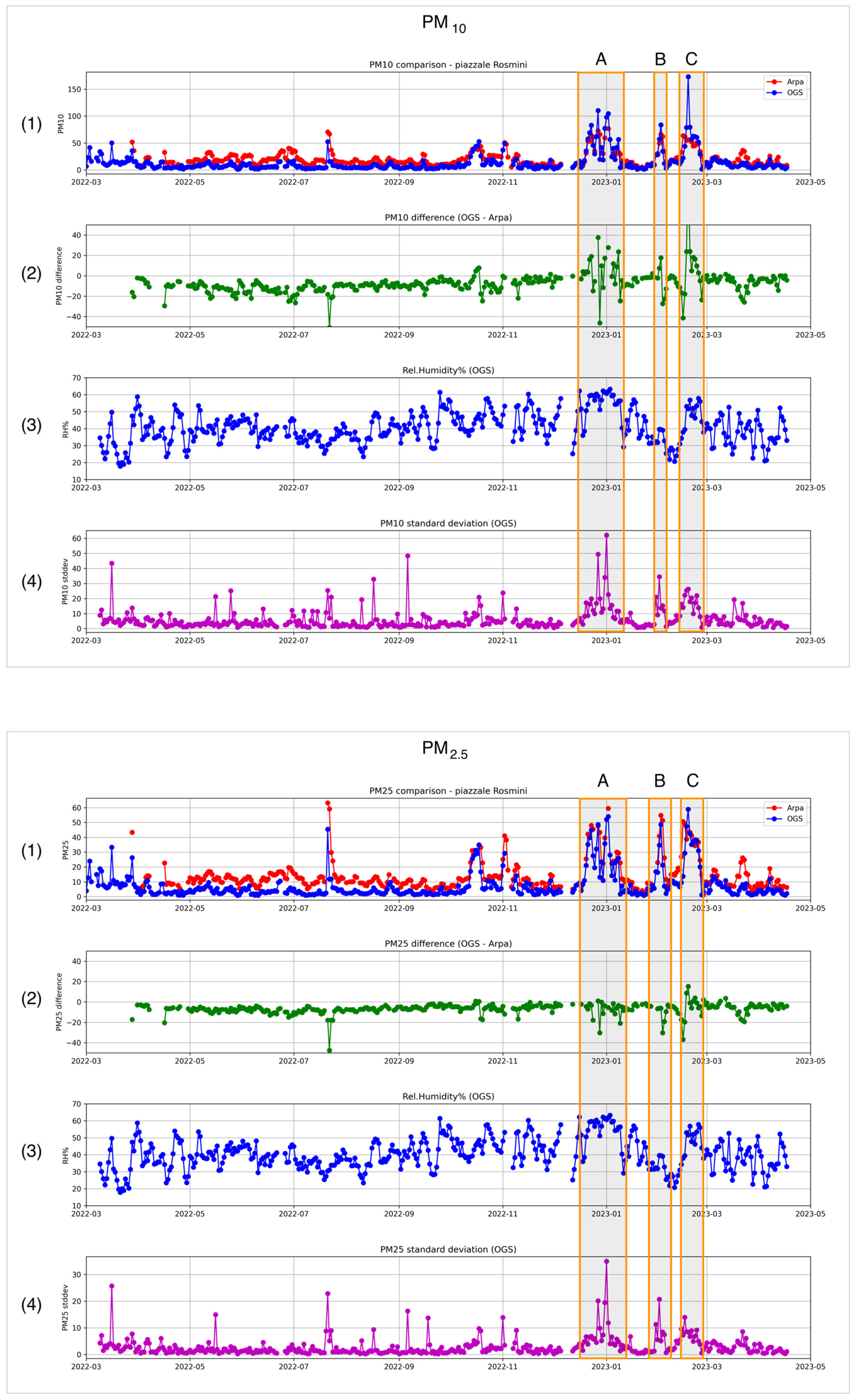



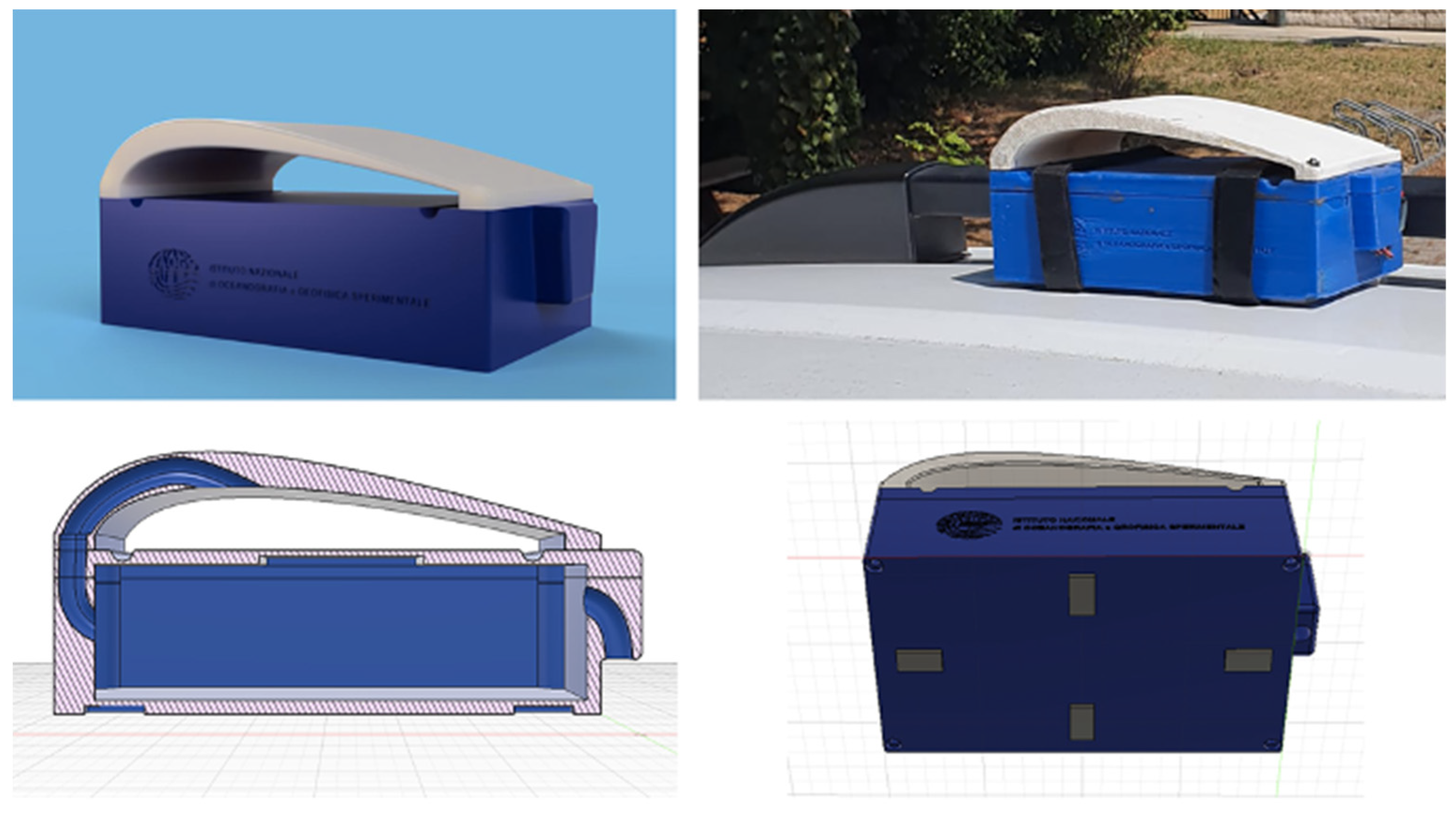
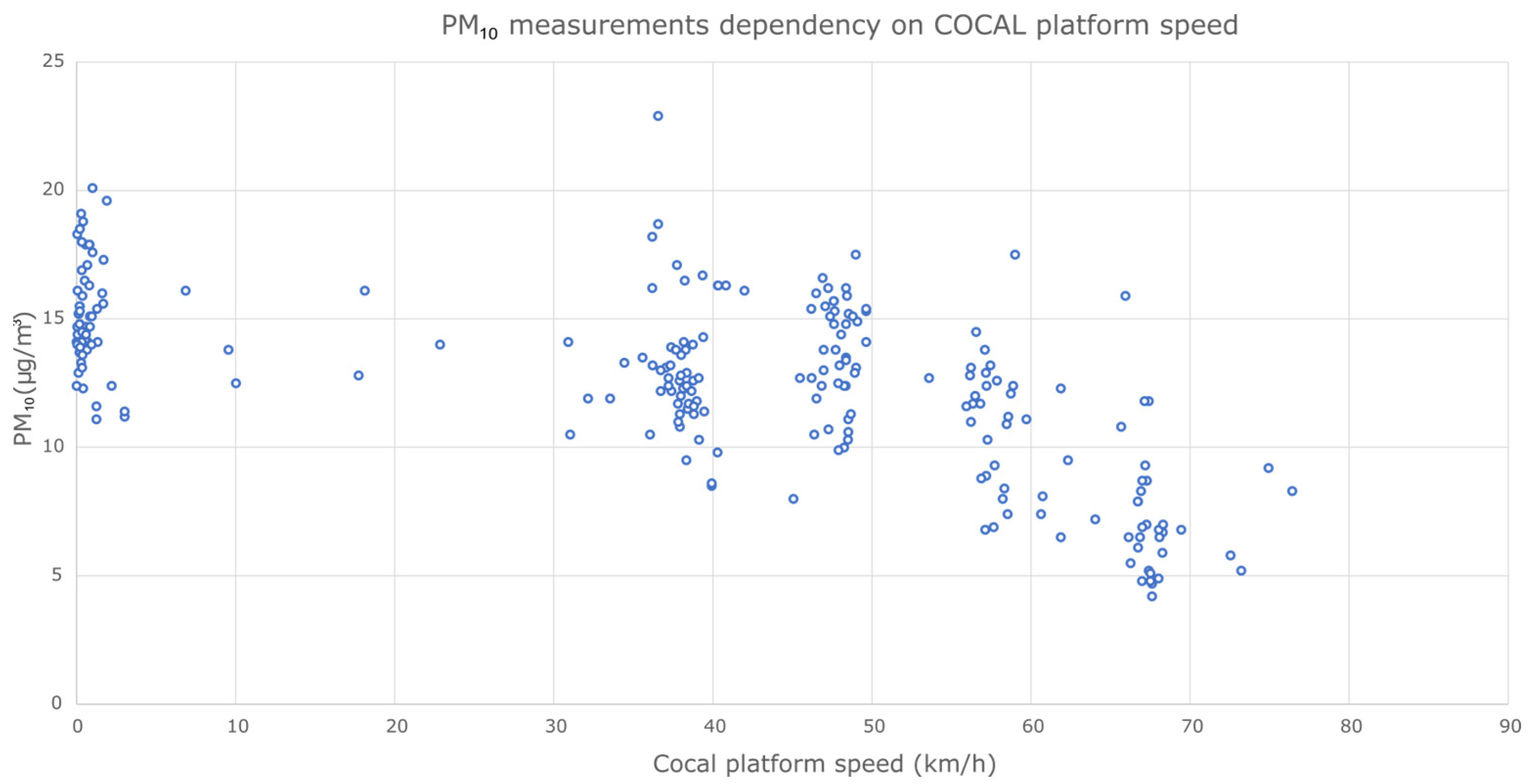

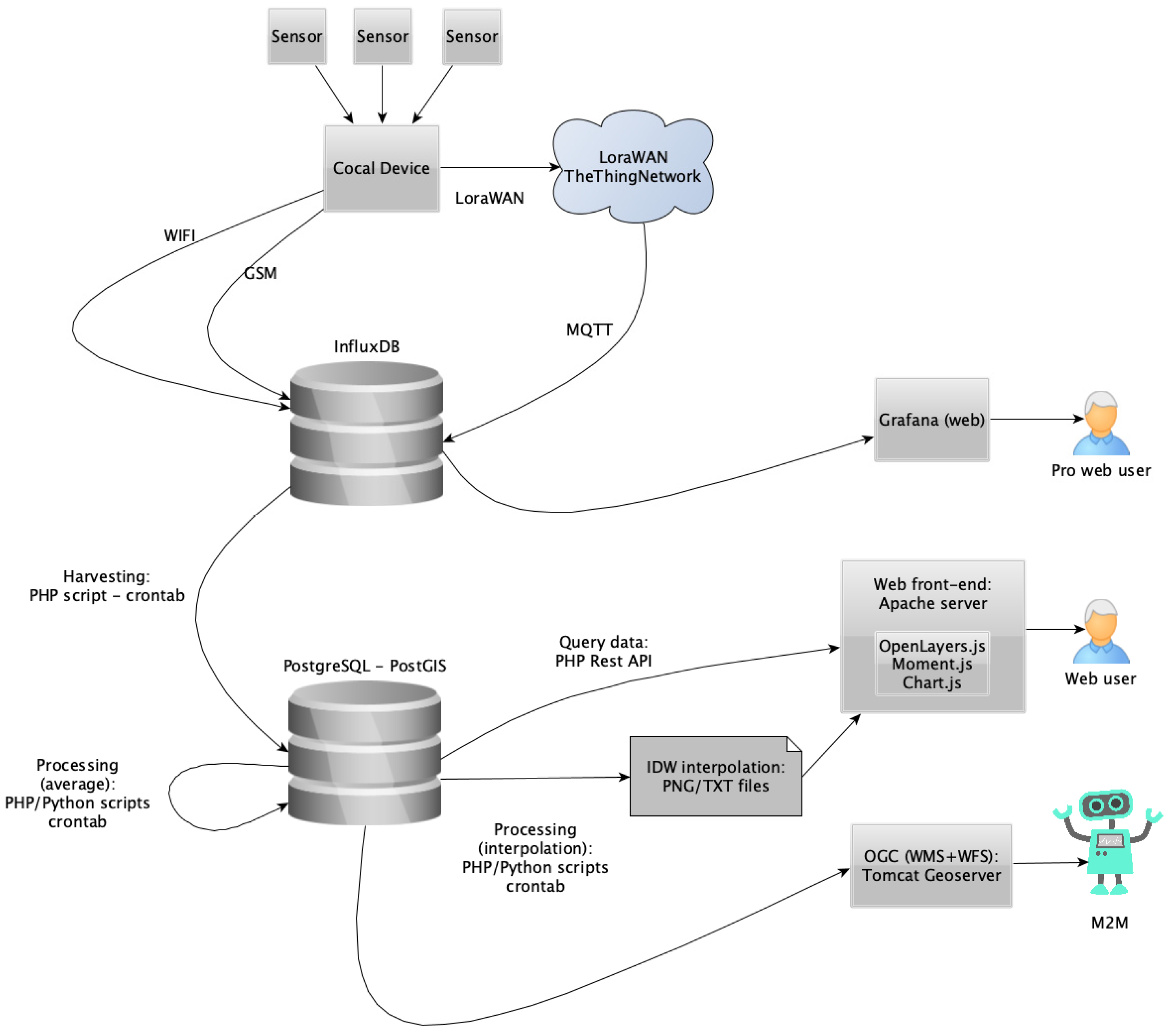



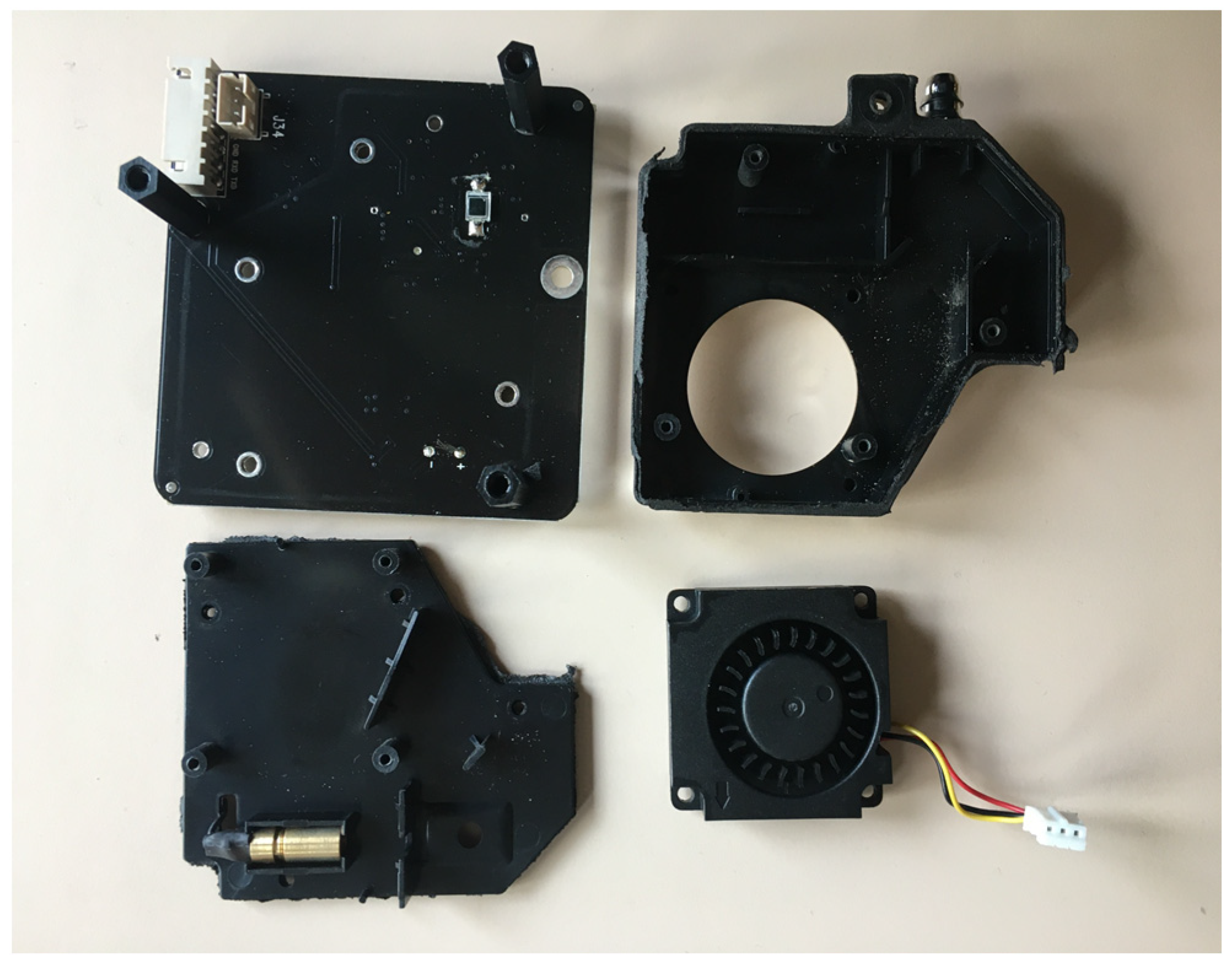
| Parameter | PM10 | PM2.5 |
|---|---|---|
| Coefficient of Determination (R2) | 0.45 | 0.25 |
| Slope | 1.06 | 0.80 |
| Intercept (b) | −8.73 | −4.09 |
| Root Mean Square Error (RMSE) | 13.76 | 8.73 |
| Normalized Root Mean Square Error (NRMSE) | 66.04 | 60.37 |
| Record Type | Total Count | Year | Count |
|---|---|---|---|
| Points | 53M | 2020 | 3.8M |
| 2021 | 13M | ||
| 2022 | 27M | ||
| 2023 (partial) | 9.2M | ||
| Cells | 18M | 2020 | 0.9M |
| 2021 | 5.8M | ||
| 2022 | 9.4M | ||
| 2023 (partial) | 1.8M |
Disclaimer/Publisher’s Note: The statements, opinions and data contained in all publications are solely those of the individual author(s) and contributor(s) and not of MDPI and/or the editor(s). MDPI and/or the editor(s) disclaim responsibility for any injury to people or property resulting from any ideas, methods, instructions or products referred to in the content. |
© 2023 by the authors. Licensee MDPI, Basel, Switzerland. This article is an open access article distributed under the terms and conditions of the Creative Commons Attribution (CC BY) license (https://creativecommons.org/licenses/by/4.0/).
Share and Cite
Diviacco, P.; Iurcev, M.; Carbajales, R.J.; Viola, A.; Potleca, N. Design and Implementation of a Crowdsensing-Based Air Quality Monitoring Open and FAIR Data Infrastructure. Processes 2023, 11, 1881. https://doi.org/10.3390/pr11071881
Diviacco P, Iurcev M, Carbajales RJ, Viola A, Potleca N. Design and Implementation of a Crowdsensing-Based Air Quality Monitoring Open and FAIR Data Infrastructure. Processes. 2023; 11(7):1881. https://doi.org/10.3390/pr11071881
Chicago/Turabian StyleDiviacco, Paolo, Massimiliano Iurcev, Rodrigo José Carbajales, Alberto Viola, and Nikolas Potleca. 2023. "Design and Implementation of a Crowdsensing-Based Air Quality Monitoring Open and FAIR Data Infrastructure" Processes 11, no. 7: 1881. https://doi.org/10.3390/pr11071881
APA StyleDiviacco, P., Iurcev, M., Carbajales, R. J., Viola, A., & Potleca, N. (2023). Design and Implementation of a Crowdsensing-Based Air Quality Monitoring Open and FAIR Data Infrastructure. Processes, 11(7), 1881. https://doi.org/10.3390/pr11071881










